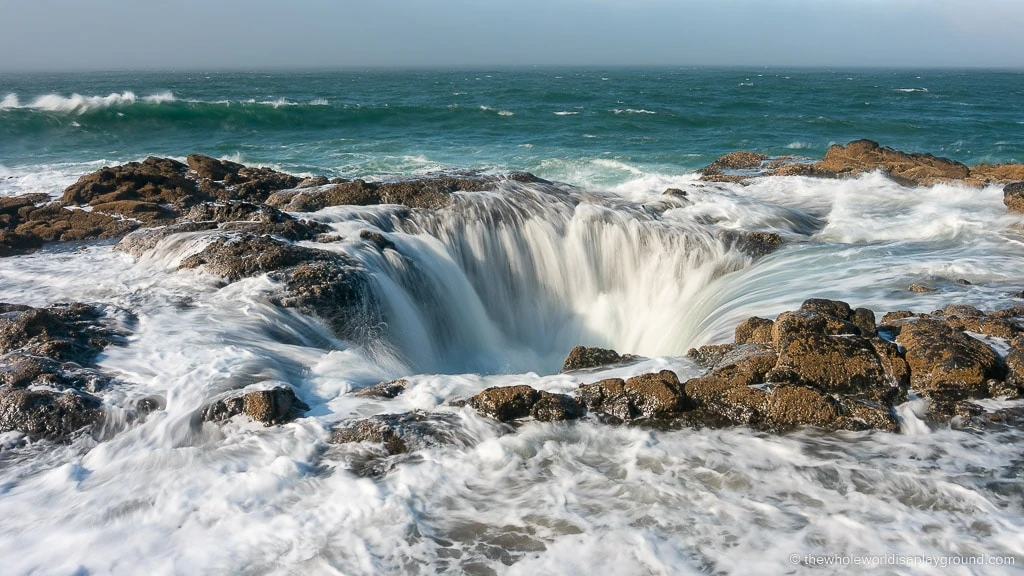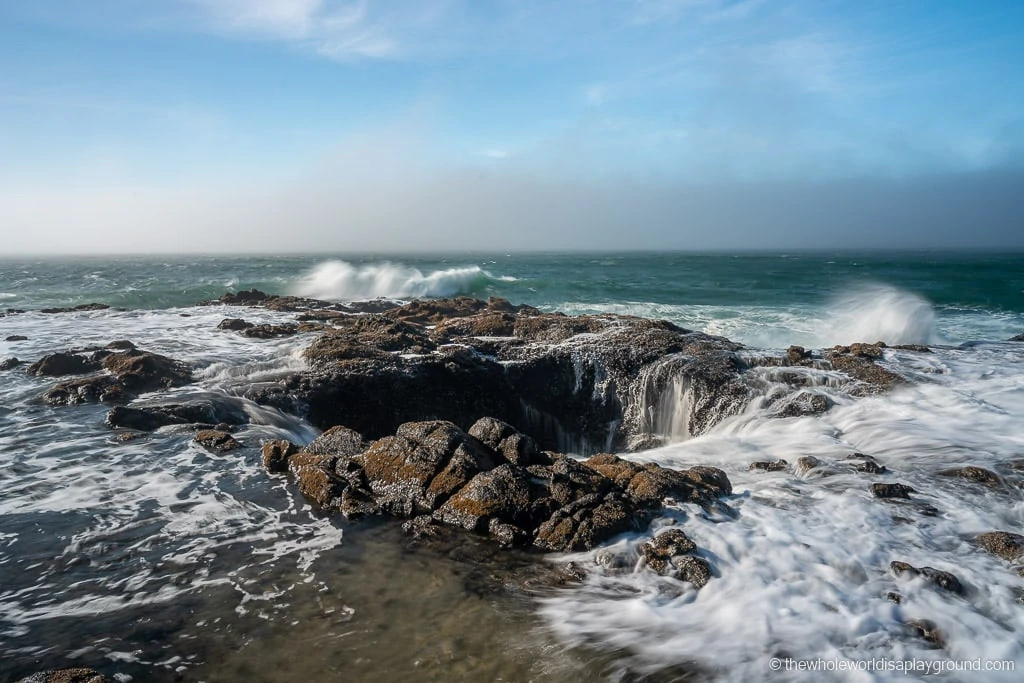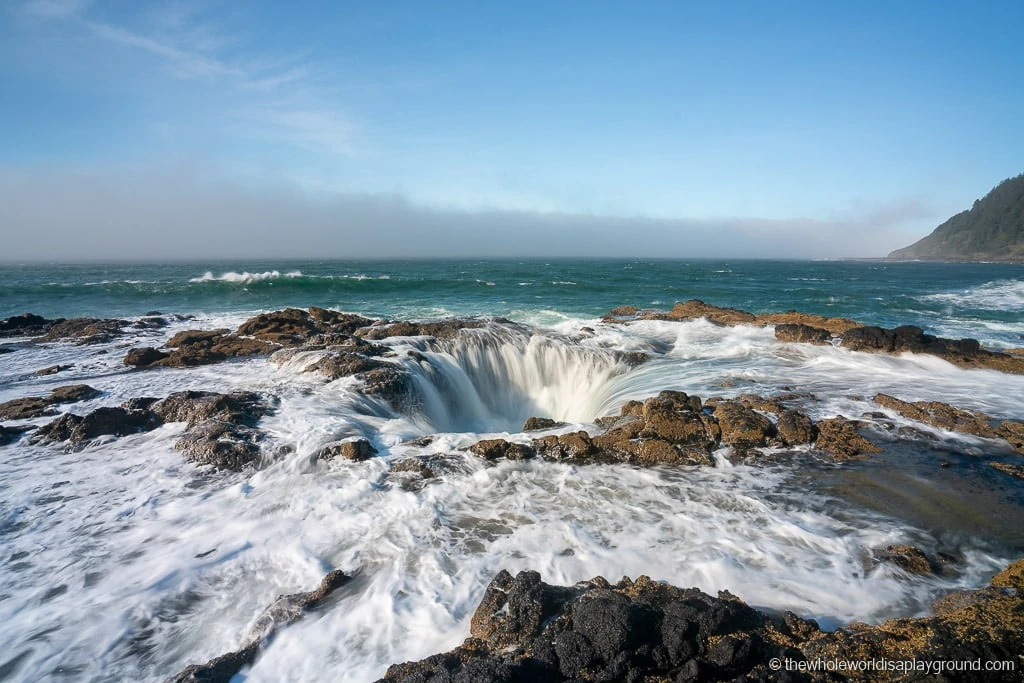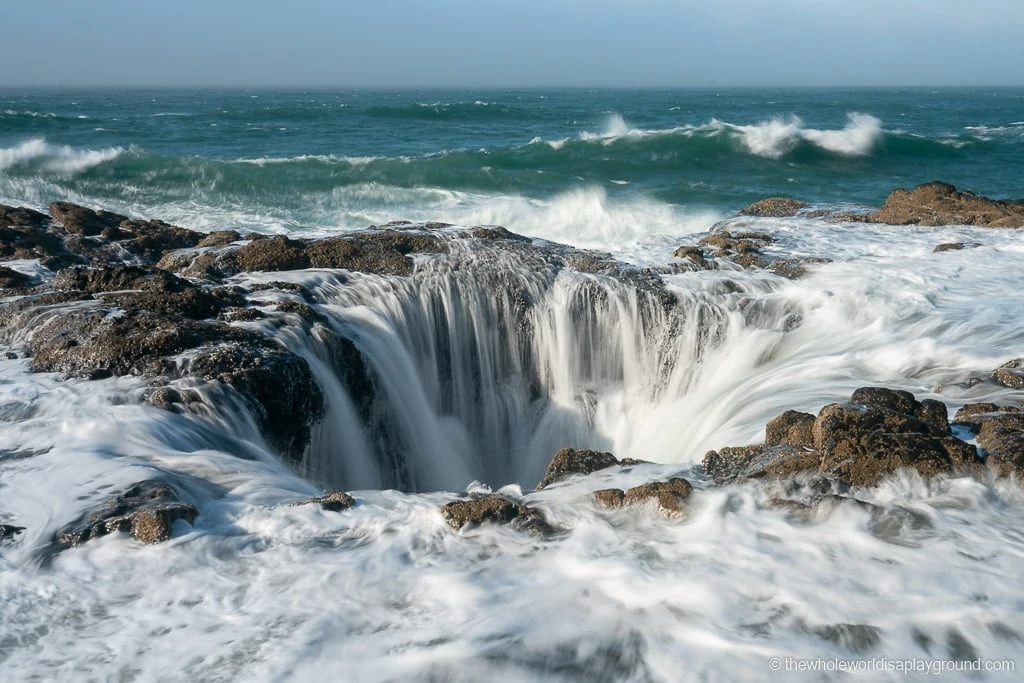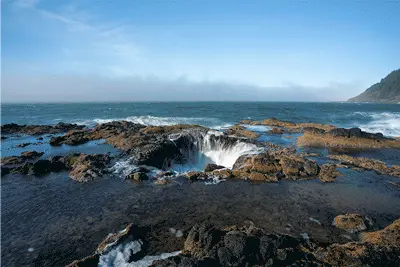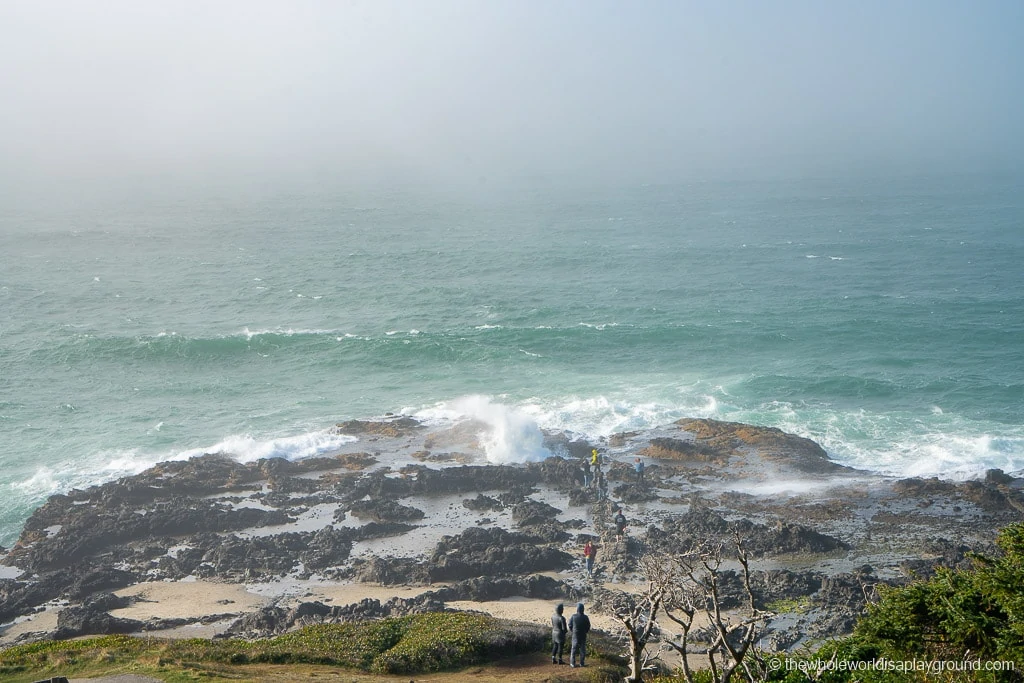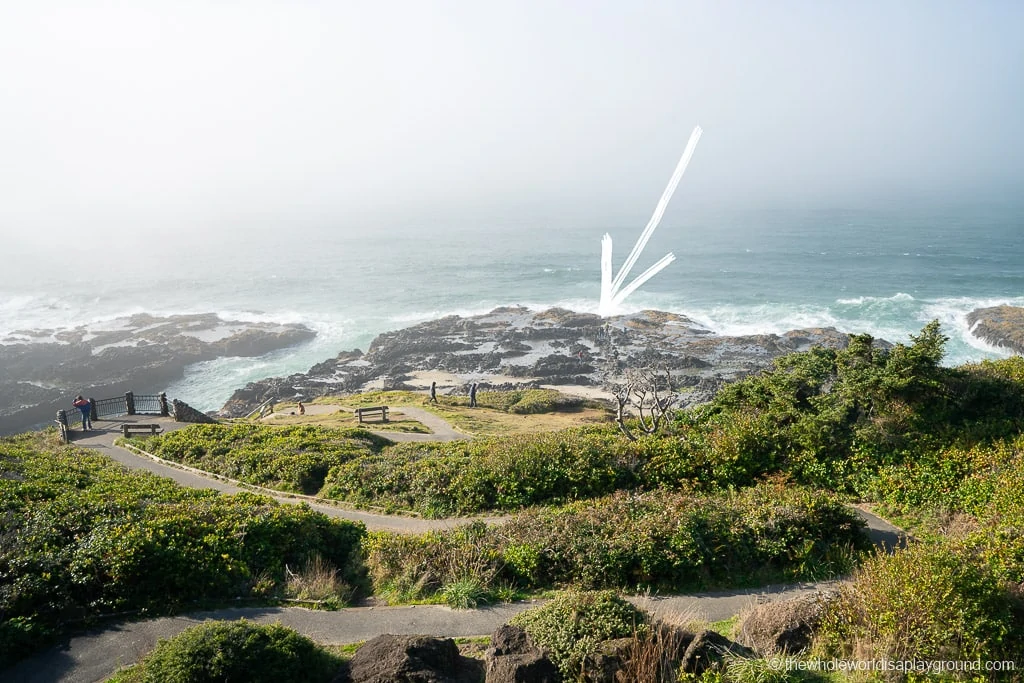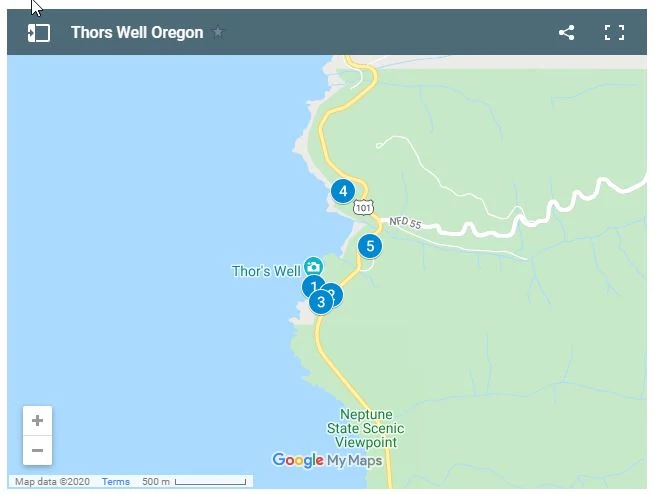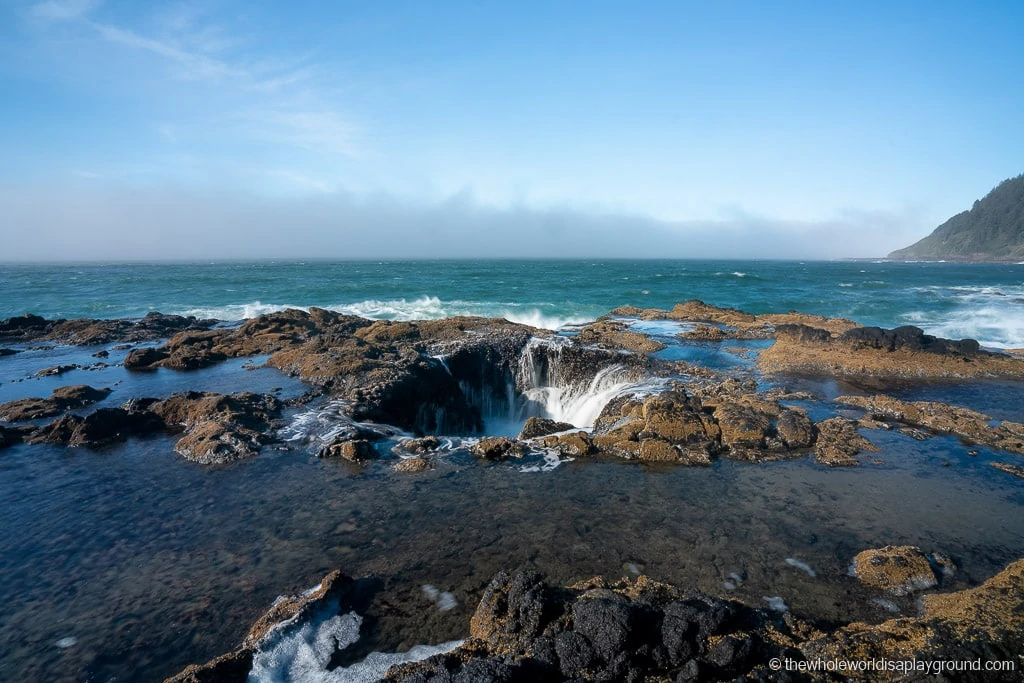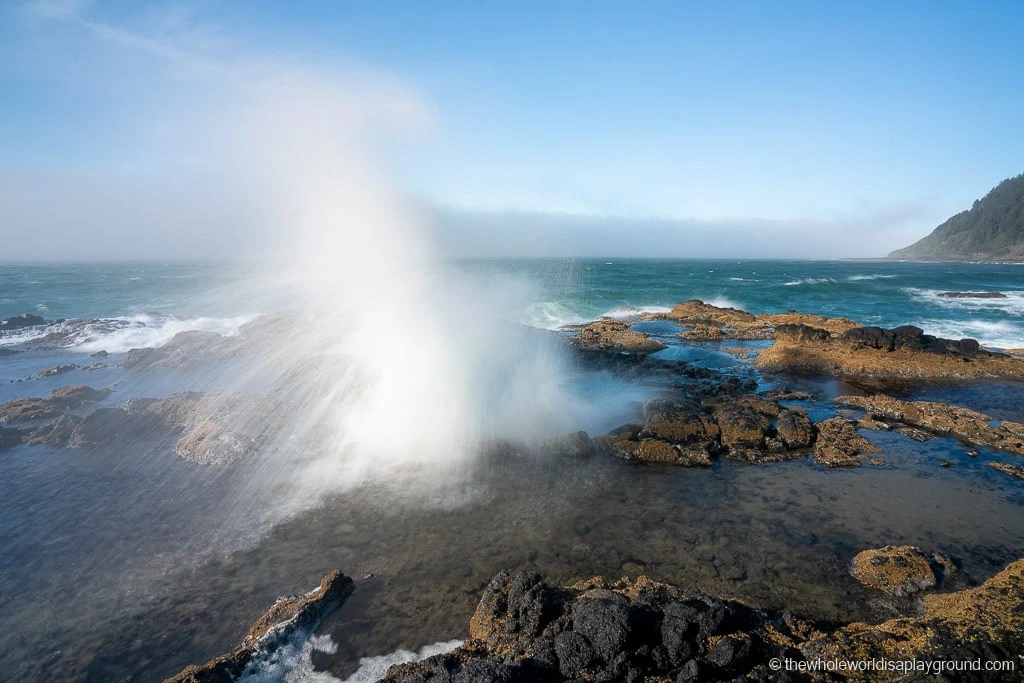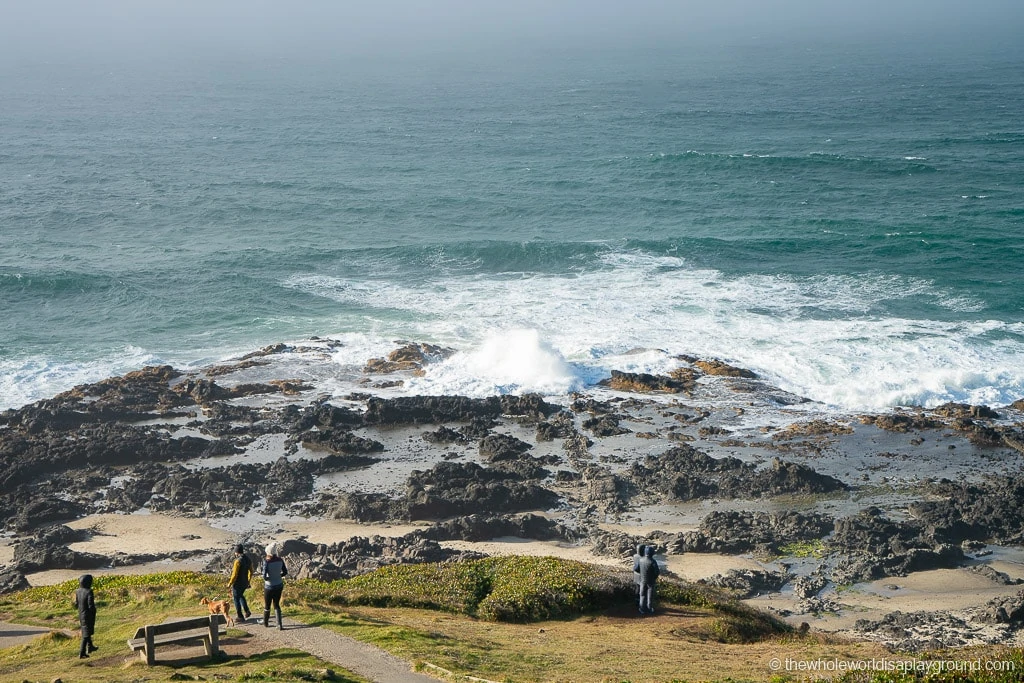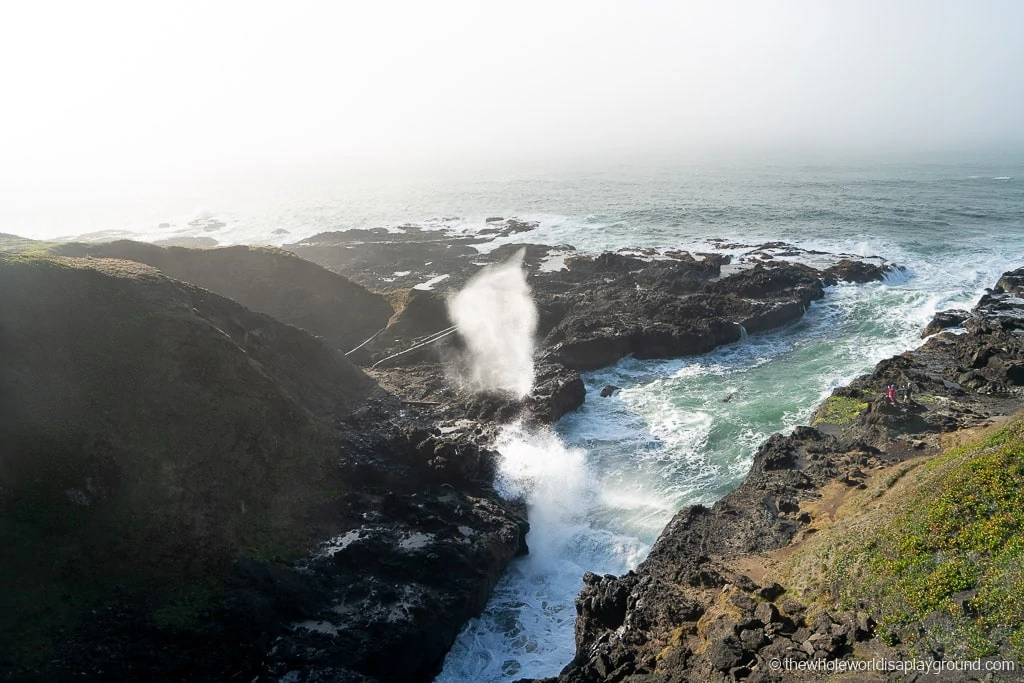Thor’s Well is a gaping hole on the edge of the Pacific Ocean which appears to swallow the ocean and powerfully shoots it back out over the surrounding rocks. Known as the ‘Drainpipe of the Pacific’, Thor’s Well is one of the most unique sights on the Oregon Coast and is mesmerizing to watch. We visited Thor’s Well during our incredible Oregon Coast road trip and, for those of you planning your own Oregon Coast itinerary, we’ve put together this guide on Thor’s Well, including the best time to visit and how to capture some amazing photos of nature at its best.
What is Thor’s Well?
Thor’s Well is a bowl shaped hole in the coastal rock that meets the Pacific Ocean on the edge of the Oregon Coast. It was formed when the thrashing ocean eroded a sea cave causing it to collapse and left a natural hole, around 20 feet deep, in the rock.
When the tide is high or the weather stormy, the waves of oncoming tides surge water under the bowl shaped hole filling it from underneath. After a few seconds the bowl overflows and sprays water over the surrounding rocks creating a very unique sight. It’s almost like Thor’s Well is draining the ocean and shooting it back out!
Thor’s Wells draws tourists, photographers and nature lovers to gaze upon the powerful display of nature. It’s especially popular at high tide when Thor’s Well is in full force.
What is the Best Time to visit Thor’s Well?
High tide and stormy weather showcase Thor’s Well at its finest and are the most popular times to visit. For those who want to get up close, it’s best to visit close to high tide on a relatively calm day. This will give the safest conditions for approaching Thor’s Well and will also ensure the well fills with enough water to shoot it back out over the rocks. At low tides there likely won’t be enough water coming into Thor’s Well to allow it to fill and overflow.
Thor’s Well Tip: make sure to check the tide times before you visit: the best time to visit is in the approach to high tide. By arriving a little early, you can check out how Thor’s Well looks without water and, as it reaches high tide, the well has the best chance of filling with water and shooting it back out. You can check tide times here.
Is Thor’s Well dangerous?
If you are careful where you walk and mind your footing on jagged rocks, it is possible to safely visit Thor’s Well. However, the Pacific Ocean can be dangerous and unpredictable and the biggest risk arises from unexpected huge waves or a sudden sneaker wave. These rogue waves occur without warning and are are a possibility at any time on the Oregon Coast. They can easily sweep you off your feet or, worse, pull you into the water.
We are experienced photographers and are used to working challenging environments like those at Thor’s well. Anyone seeking to get close to Thor’s Well do so at their own risk.
Thor’s Well tip: always remain on the land side of Thor’s Rock and use extreme caution.
If you are not comfortable going out to Thor’s Well itself it is also possible to watch the action from the viewing area at the bottom of the path.
While the ocean is obviously a huge risk at Thor’s Well, the sharp volcanic rock that surrounds it can give you a nasty gash if you miss your footing an fall. So be wary of the sharp rocks!
Is it worth visiting Thors Well?
In one word, YES! Thor’s Well was one of the most unique and coolest things we visited in Oregon and, as long as care is taken, we highly recommend it to our readers.
Where is Thor’s Well in Oregon?
Thor’s Well is located just over 3 miles south of the seaside town of Yachats on Cape Perpetua on the Oregon Coast. It’s most easily visited by car and there is a parking lot, Cook’s Chasm, located just off Route 101. A short walk down from the parking lot takes visitors to the edge of the rocky headland and the viewing area for Thor’s Well. It’s possible to see Thor’s well from here but the best views and photo opportunities are from out of the rocks.
The well itself is located across the dark volcanic rock close to the waters edge directly in front of the parking lot. You can easily see the well from parking are and the viewing area at the bottom of the path. For those who want a closer look at Thor’s Well, continue out carefully onto the black volcanic rocks at the bottom of the path from the parking lot. There is rough rocky track that leads directly to Thor’s Well.
Map of Thor’s Well in Oregon
We also put together the below map for planning your trip to Thor’s Well and the surrounding sights. Click on the link to explore further.
How to Use This Google Map: Click on the grey star at the top of the map and this map will be added to your Google Maps account. You can then view it on your phone or computer in Google Maps by clicking on the menu button, going to “Your Places” and selecting this map. We use these maps all the time as you can set out your itinerary ahead of time and quickly reference the saved maps.
Why is it Called Thors Well?
Thors Well is called after the Norse God of Thunder, Thor. As the local legend goes, Thor created the well after striking the rocks, creating the large sinkhole to the ocean bed below.
Visiting Thor’s Well
As you approach Thor’s Well the power of the ocean and nature will quickly become evident. A few seconds after a wave hits the headland the swell makes it way under the rock and shoots up from Thor’s Well drenching the surrounding rocks. The power of the water is very unpredictable and a large wave won’t necessarily mean an impressive swell in Thor’s Well!
Thor’s Well tip: For those who venture out to Thor’s Well it is highly likely that you’re going to get wet. Possibly very wet! Make sure to protect your phone and camera equipment.
We cannot emphasize how dangerous this area of the Oregon Coast can be. Even in seemingly calm conditions, the unpredictability of the ocean always poses a risk. The best advice we can offer is only attempt to walk out to Thor’s Well if you are comfortable, never turn your back to the waves and don’t get too close to the edge or the well itself. Do not bring kids further than the designated viewing areas.
Tips for Photographing Thor’s Well
Lots of visitors come to Thor’s Well to capture the incredible image of Thor’s Well swallowing nd sprouting the waves. We loved capturing Thor’s Well in action, so we’ve put together our tips for getting the best images during your visit.
- Shoot from in front of Thor’s Well: To capture the iconic shot of the waters receding and flowing from Thor’s Well you will have to walk out across the rocky headland to get close to the hole – there’s no real way around this part and you do so at your own risk.
- Visit at high tide: At higher tides the ocean will be close to the flat rocky area around Thors Well and the swells will be coming up through the hole and probably washing up over the rocky shoreline. These are the ideal conditions for capturing the beauty of Thor’s Well so make sure to check tide times before you go.
- Angels: we found the best angles to be in front of the sinkhole looking out to sea with the highway to our back. You don’t have to get very close to the hole to get great shots. I stood back around 8 to 10 feet from the edge on all my shots And yes, I did get wet up to my knees!.
- Tripod: You’ll need a sturdy tripod for your camera and, once you’ve setup, don’t let go of it. You will probably need to grab it and step back when a larger wave strikes.
- ND Filter: to capture the longer exposures which show the water movement you’ll need an ND filter. I used a 3 stop ND Nisi filter to capture the images in the post with a remote shutter release to help time the shots.
- Polarizing Filter: to remove the reflection and make the water pop a polarizing filter is also a must.
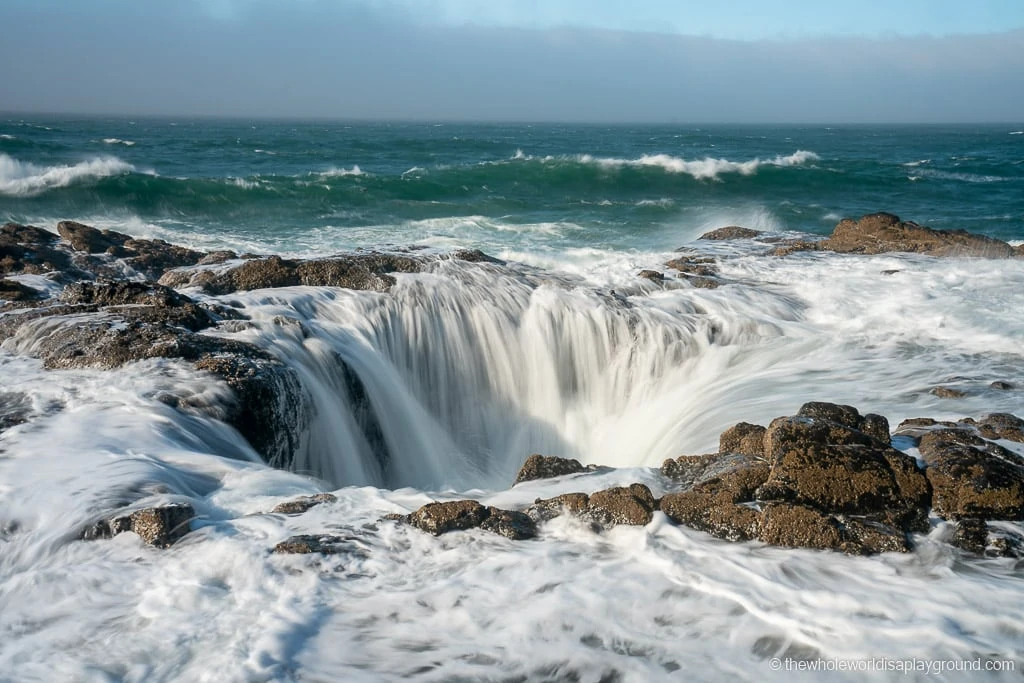
- You’ll also need a cloth to keep your lens/filters dry and free from ocean splashes. Even without a direct splash there is so much sea spray here that you’re lens will get tiny water spray that will affect your shots. I always carry a few microfibre cloths up my sleeve for situations like these – check prices now!
Other things to See Nearby
Thor’s Well is located close to a few other Oregon Coast gems.
Spouting Horn
Don’t forget to check out Spouting Horn which is located close to Thor’s Well. This natural ocean blowhole is located just south of Thor’s Well on the far side of Cook’s Chasm beside Thor’s Well viewing area. The incoming waves crash into an underwater cave forcing seawater and spray out the sprout of Spouting Horn launching water and spray into the air. There’s a good view of Spouting Horn from the bridge beside the Cook’s Chasm parking lot.
Devils Churn
Devils Churn is another amazing sight on the Oregon Coast and is located just north of Thor’s Well. Waves come crashing into the narrow inlet and churn up water and spray over the surrounding rocks.
